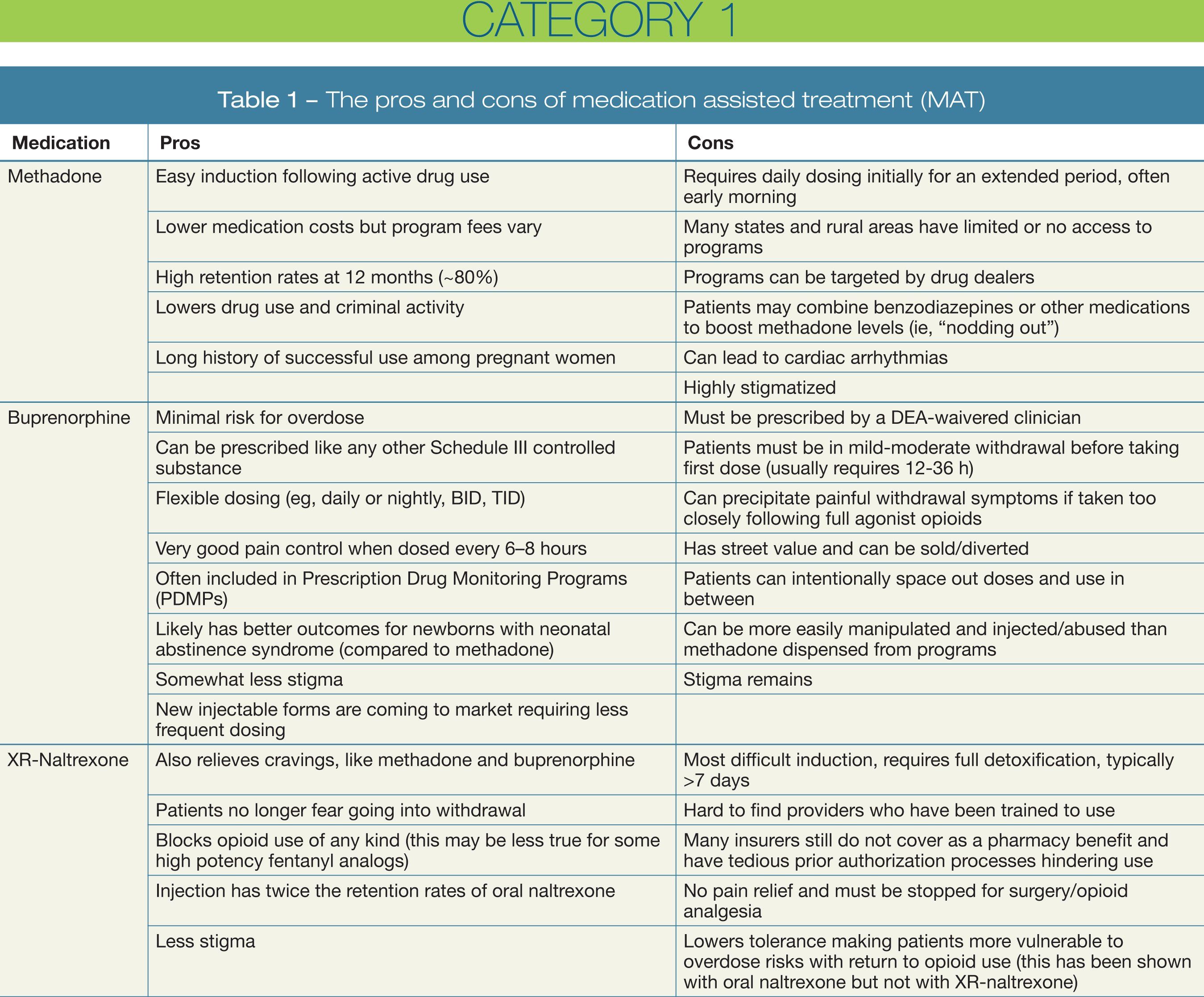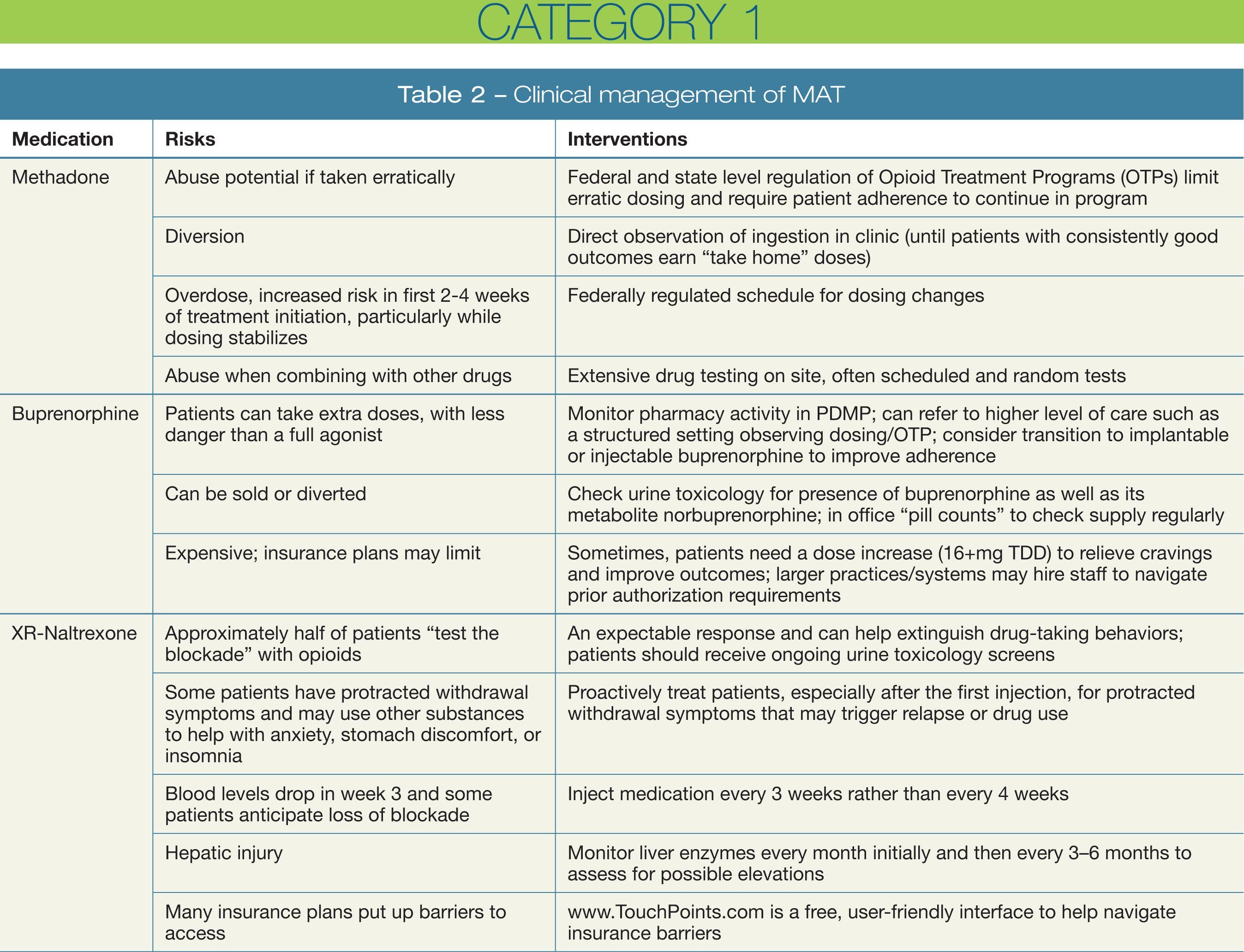Publication
Article
Psychiatric Times
Responding to the Opioid Epidemic and Expanding Access to Quality Treatment
Author(s):
The US is facing the largest epidemic of opioid overdose deaths in its history. This CME addresses issues associated with the medication-assisted treatment protocol for opioid use disorder.
Arthur Robin Williams, MD, MBE

Table 1. The pros and cons of medication assisted treatment (MAT)

Table 2. Clinical management of MAT

Table 3. Barriers to accessing evidence-based care with MAT[3,17]

PREMIERE DATE: May 20, 2018
EXPIRATION DATE: November 20, 2019
This activity offers CE credit for:
1. Physicians (CME)
2. Other
All other clinicians either will receive a CME Attendance Certificate or may choose any of the types of CE credit being offered.
ACTIVITY GOAL
To recognize the issues associated with using the MAT (medication-assisted treatment) protocol for opioid use disorder.
LEARNING OBJECTIVES
At the end of this CE activity, participants should be able to:
• Evaluate the pros and cons of each of the three medications available in MAT
• Rationalize the need for long-term treatment for best outcomes
• Understand the clinical management of opioid use disorder
• Explain the barriers associated with the use of MAT
TARGET AUDIENCE
This continuing medical education activity is intended for psychiatrists, psychologists, primary care physicians, physician assistants, nurse practitioners, and other health care professionals who seek to improve their care for patients with mental health disorders.
CREDIT INFORMATION
CME Credit (Physicians): This activity has been planned and implemented in accordance with the Essential Areas and policies of the Accreditation Council for Continuing Medical Education (ACCME) through the joint providership of CME Outfitters, LLC, and Psychiatric Times. CME Outfitters, LLC, is accredited by the ACCME to provide continuing medical education for physicians.
CME Outfitters designates this enduring material for a maximum of 1.5 AMA PRA Category 1 Credit™. Physicians should claim only the credit commensurate with the extent of their participation in the activity.
Note to Nurse Practitioners and Physician Assistants: AANPCP and AAPA accept certificates of participation for educational activities certified for AMA PRA Category 1 Credit™.
DISCLOSURE DECLARATION
It is the policy of CME Outfitters, LLC, to ensure independence, balance, objectivity, and scientific rigor and integrity in all of their CME/CE activities. Faculty must disclose to the participants any relationships with commercial companies whose products or devices may be mentioned in faculty presentations, or with the commercial supporter of this CME/CE activity. CME Outfitters, LLC, has evaluated, identified, and attempted to resolve any potential conflicts of interest through a rigorous content validation procedure, use of evidence-based data/research, and a multidisciplinary peer-review process.
The following information is for participant information only. It is not assumed that these relationships will have a negative impact on the presentations.
Arthur Robin Williams, MD, MBE, reports that his work is funded by NIDA grant #K23DA044342, “Improving the treatment cascade of MAT initiation and retention for opioid use disorder.” He also receives research funding from the Smithers Foundation. He reports no conflicts of interest.
Steve Koh, MD (peer/content reviewer), he has no disclosures to report.
Applicable Psychiatric Times staff and CME Outfitters staff, have no disclosures to report.
UNLABELED USE DISCLOSURE
Faculty of this CME/CE activity may include discussion of products or devices that are not currently labeled for use by the FDA. The faculty have been informed of their responsibility to disclose to the audience if they will be discussing off-label or investigational uses (any uses not approved by the FDA) of products or devices. CME Outfitters, LLC, and the faculty do not endorse the use of any product outside of the FDA-labeled indications. Medical professionals should not utilize the procedures, products, or diagnosis techniques discussed during this activity without evaluation of their patient for contraindications or dangers of use.
Questions about this activity?
Call us at 877.CME.PROS (877.263.7767)
The US is facing the largest epidemic of opioid overdose deaths in its history: in 2016, annual unintentional overdose fatalities from opioids are estimated to have exceeded 42,000 (more than 115 deaths every day).1 Approximately 2.4 million individuals in the US have an opioid use disorder (OUD). However, this number is likely an underestimation of the true burden.2 For instance, the National Survey on Drug Use and Health surveys about 67,500 non-institutionalized individuals each year.3 As a result, many at highest risk of OUD (eg, incarcerated and institutionalized persons, the chronically homeless) are likely not to have been included. Moreover, recent fieldwork has shown that heroin use has been increasing more rapidly than may be reflected in national surveys.4
CASE VIGNETTE
"Vincent," aged 28 years, is facing a 2-year sentence for a criminal charge (his first). He has been sniffing 8 to 10 bags of heroin a day for the past 6 months after regularly using 120 to 150 mg of oxycodone daily for the past 5 years. Initially, he only used oxycodone on the weekends when drinking with friends. Over a few years, the drug became a daily habit he needed to get through the work day. He has never been in drug treatment, but last year when he didn’t have enough money for oxycodone, he tried “bup” from a friend and it made him “sick.”
Vincent has managed to keep a construction job and works 6 AM to 3 PM most days. He lives with his mother. He says that he hates using heroin, but every time he tries to stop he has withdrawal symptoms, such as nausea, diarrhea, and muscle aches, and he cannot go to work. Sometimes if he doesn’t use, he becomes irritable with coworkers and debilitated by anxiety. He has not made it more than 24 hours without using for the past year. Aside from his drug addiction and related symptoms, Vincent denies other mood, anxiety, or trauma disorder symptoms.
Clinical management of OUD
Because OUD poses greater risks than other use disorders, it requires a different approach when evaluating risks and benefits of treatment. OUD is a chronic, relapsing disorder; therefore a treatment approach that involves only detoxification without maintenance medication is likely to be harmful because of the high risk of relapse and overdose death following periods of abstinence.5,6 Medication-assisted treatments (MAT), methadone, buprenorphine, and extended-release naltrexone, approved by the FDA, have strong empiric evidence for superior outcomes compared with medication-free behavioral approaches or short-term detoxification.7,8 (Table 1 presents the pros and cons of MAT modalities; see Table 2 regarding MAT clinical management.)
Methadone
Methadone, FDA approved in 1972, is taken once daily. Methadone fully stabilizes opioid receptors for approximately 24 hours. Methadone maintenance is the most well-established treatment for OUD and when given at adequate doses (typically > 60–120 mg/d), is associated with reducing illicit opioid use and overdose death, with decreasing criminality, and with increasing employment.9 Methadone treatment for addiction is only available through strictly regulated opioid treatment programs accredited by the Substance Abuse and Mental Health Services Administration (SAMHSA). Persons with OUDs initially attend the opioid treatment program daily before receiving take-home doses.
Buprenorphine
Buprenorphine was FDA-approved in 2002 and works similarly to methadone but only partially activates opioid receptors, limiting overdose risk. Due to a lower risk of overdose than methadone, buprenorphine can be prescribed by physicians in general outpatient settings or attached to specialty treatment programs, also known as Office Based Opioid Treatment. Buprenorphine represents an important alternative maintenance treatment for patients unable or unwilling to attend methadone programs. Prescribers must go through a brief training and obtain a DEA “waiver.” Nurse practitioners and physician assistants can now also prescribe buprenorphine after obtaining a “waiver,” although they must first go through lengthier training. A major limitation of buprenorphine-based MAT is that providers are hard to find, especially in rural areas.
In general, patients with OUD have a 50% reduction in all-cause mortality while actively in treatment with methadone or buprenorphine.7 Given the robust evidence for clinical effectiveness, methadone and buprenorphine are included on the World Health Organization list of essential medicines, intended to be available and utilized in health systems at all times. Because of the tremendous benefits of buprenorphine for stabilizing active opioid use and reducing overdose risk, increased attention has been paid to innovative models for expanding access to same-day inductions such as through emergency rooms as well as expanding caseloads via tele-medicine.10
Which MAT modality would be the best fit for Vincent? What is the recommendation if Vincent also has chronic pain?
Buprenorphine may be the best fit for Vincent depending on local availability. With pain, buprenorphine dosed every 6 to 8 hours (ie, 4 mg q6h) would be preferable to methadone, which can accumulate in the blood levels over a one to two day period.
Naltrexone
Naltrexone completely blocks opioid receptors and has been available as an extended-release monthly injection (XR-naltrexone) since 2010. Naltrexone can be given to protect patients from opioid relapse following detoxification. It has become a favored treatment option in many criminal justice settings, as patients do not develop tolerance or withdrawal while taking it and it cannot be abused.11 However, full detoxification from opioids before starting XR-naltrexone can be a hurdle to induction for many patients, especially those with more severe addiction and psychiatric comorbidity. Regardless, recent head-to-head studies have shown that once patients initiate XR-naltrexone, they have similar or superior outcomes than those on buprenorphine.8
Would naltrexone work for Vincent? What if he also has chronic pain?
XR-Naltrexone is a good choice for Vincent. However, he would need to stop using for a week before he could receive a naltrexone injection. Moreover, with comorbid pain, Vincent would need additional non-opioid analgesia since naltrexone does not treat pain.
Long-term treatment
OUD is a chronic disorder that requires ongoing treatment. Most patients relapse following cessation of MAT and relapse carries a risk of sudden overdose death. Long-term retention in treatment is associated with the most favorable outcomes.12 In addition to well-established clinical effectiveness, MAT produces cost-savings throughout the health care system by reducing inpatient and outpatient service utilization, pharmacy costs, and total expenditures.13 As a result, efforts to improve long-term retention (ie, beyond a minimum of 6 months), as recently endorsed by the National Quality Forum, without limits on treatment duration are often needed to maximize outcomes. Contingency management, motivational interviewing, and cognitive behavioral therapy have all shown promise in improving retention rates on MAT pharmacotherapies.
There are no studies that show benefit from discontinuing MAT. In general, the longer the treatment, the better the outcomes. A minimum of 12 months improves results, but indefinite treatment under a chronic medical illness model is often necessary. Patients should only be discontinued when clinically indicated -not for insurance or financial reasons.
Barriers to evidence-based care with MAT
Despite strong evidence for the effectiveness of MAT, the rates of initiation and retention beyond 6 months are low.14 Currently only about 20% of the estimated 2.4 million individuals with OUD are engaged in treatment.15 And only approximately 35% of those in treatment receive one of the MAT medications upon entering specialty care; consequently, the 6-month retention rate is less than 30% to 50% in most settings. Only a fraction of individuals with OUD achieve long-term remission in the US following a single episode of care, which contributes to our escalating opioid overdose mortality rate.16
At present, barriers to receiving care with MAT span many aspects of the drug treatment system (Table 3). Seventeen states have Medicaid programs that do not cover methadone maintenance and publicly funded programs often arbitrarily limit treatment duration.17 Although addiction treatment has been deemed one of ten “essential health benefits” under the Affordable Care Act, methadone and buprenorphine maintenance has not been included in the mandate. Recently, professional and consumer advocacy groups have been petitioning CMS to explicitly mandate MAT coverage under essential health benefits for substance abuse treatment.
Even with private or public insurance coverage, patients with OUD are often difficult to engage in treatment. Many patients in need of substance abuse treatment lack insight into the severity of their condition and do not willingly seek treatment. Many primary care settings are ill equipped to treat psychiatric comorbidity among patients with OUD or lack the resources for comprehensive services to engage patients. Given these challenges, specialized addiction services provided through publicly funded substance abuse treatment programs (both outpatient and residential) are likely to remain vital to the care of patients who are addicted to opioids. Yet institutionalized ideology favoring medication-free (“abstinence-only”) approaches modeled on treating alcoholism in the mid-20th century persists throughout these programs and some patients feel stigmatized for using MAT.
Resources for the clinician
There is no simple solution for resolving an epidemic as complex as the current opioid crisis. However, clinicians throughout the health care system can identify and effectively treat patients with OUD to reduce the risk of overdose and death. There is extensive and freely available training as well as resource materials online to help clinicians learn more about MAT pharmacotherapy.
PCSS-MAT is a robust online mentorship initiative funded by SAMHSA and spearheaded by the American Academy of Addiction Psychiatry (AAAP). Many modules are posted at https://pcssmat.org/online-modules/. NIDA has a website dedicated to updates on evidence-based treatment for OUD: https://www.drugabuse.gov/publications/effective-treatments-opioid-addiction/effective-treatments-opioid-addiction. In addition, SAMHSA has published an extensive Treatment Improvement Protocol (TIP #42) on treating patients with comorbid SUDs and mental illness: https://store.samhsa.gov/product/TIP-42-Substance-Abuse-Treatment-for-Persons-With-Co-Occurring-Disorders/SMA13-3992.
CME POST-TEST
Post-tests, credit request forms, and activity evaluations must be completed online at www.cmeoutfitters.com/PT (requires free account activation), and participants can print their certificate or statement of credit immediately (80% pass rate required). This Web site supports all browsers except Internet Explorer for Mac. For complete technical requirements and privacy policy, visit www.neurosciencecme.com/technical.asp.
PLEASE NOTE THAT THE POST-TEST IS AVAILABLE ONLINE ONLY ON THE 20TH OF THE MONTH OF ACTIVITY ISSUE AND FOR 18 MONTHS AFTER.
Need Additional CME Credit?
Check Out These Free CME Activities
Lifeline for Pregnant and Postpartum Women Who are Drowning in Plain Sight
Nancy Byatt, DO, MS, MBA
Expiration date: October 20, 2019
Genetics in the Clinical Setting: The Role of Psychiatric Genetic Counseling
Jehannine Austin, PhD, CGC
Expiration date: September 20, 2019
Disclosures:
Dr Williams is Assistant Professor of Psychiatry, Division on Substance Use Disorders, Columbia University Medical Center, and Research Scientist, New York State Psychiatric Institute.
References:
1. National Vital Statistics System. Provisional counts of drug overdose deaths as of 8/6/2017. National Center for Health Statistics, Centers for Disease Control and Prevention. 2017.
2. Ruhm CJ. Geographic variation in opioid and heroin involved drug mortality rates. Am J Prev Med. 2017; 53:745-753.
3. Substance Abuse and Mental Health Services Administration. National Survey of Substance Abuse Treatment Services (N-SSATS): 2013. HHS Publication No. (SMA) 14-4890;2014 Rockville, MD.
4. Cicero TJ, Ellis M, Kasper ZA. Increased use of heroin as an initiating opioid of abuse. Addict Behav. 2017; 74:63-66.
5. Williams AR, Bisaga A. From AIDS to opioids- how to respond to an epidemic. N Engl J Med. 2016; 375:813-815.
6. Sordo L, Barrio G, Bravo MJ, et al. Mortality risk during and after opioid substitution treatment: systematic review and meta-analysis of cohort studies. BMJ. 2017;357: j1550:1-14.
7. Amato L, Davoli M, Perucci CA, et al. An overview of systematic reviews of the effectiveness of opiate maintenance therapies: Available evidence to inform clinical practice and research. J Sub Abuse Treat. 2005;28:321–329.
8. Lee JD, Nunes EV, Novo P, et al. Comparative effectiveness of extended-release naltrexone versus buprenorphine-naloxone for opioid relapse prevention (X:BOT): a multicenter, open-label, randomize controlled trial. Lancet. 2017. published online November 14, 2017. http://dx.doi.org/10.1016/S0140-6736(17)32812-X
9. Fullerton C, Kim M, Thomas CP. Medication-assisted treatment with methadone assessing the evidence. Psych Services. 2014;65(2)146-157.
10. D’Onofrio G, Chawarski MC, O’Connor PG, et al. Emergency department–initiated buprenorphine/naloxone treatment for opioid dependence: a randomized clinical trial. JAMA. 2017;28;313:1636-1644.
11. Lee JD, Friedmann PD, Kinlock TW, et al. Extended-release naltrexone to prevent opioid relapse in criminal justice offenders. N Engl J Med. 2016; 374:1232-1242.
12. McLellan AT, Lewis DC, O’Brien CP, Kleber HD. Drug dependence, a chronic medical illness: implications for treatment, insurance, and outcomes evaluation. JAMA. 2000;284:1689-1695.
13. Baser O, Chalk M, Fiellin DA, Gastfriend DR. Cost and utilization outcomes of opioid-dependence treatments. Am J Manag Care. 2011;17(Suppl 8):S235-S248.
14. Timko C, Schultz NR, Cucciare MA, et al. Retention in medication-assisted treatment for opiate dependence: a systematic review. J Addict Dis. 2016; 35:1,22-35.
15. Wu L, Zhu H, Swartz MS. Treatment utilization among persons with opioid use disorder in the United States. Drug Alcohol Depend. 2016;169:117-127.
16. Williams AR, Nunes EV, Olfson M. To battle the opioid overdose epidemic, deploy the “Cascade of Care” model. Health Affairs blog. March 13, 2017.
17. American Society for Addiction Medicine. Advancing access to addiction medications: Implications for opioid addiction treatment. Chevy Chase, Maryland. 2013:1-221.







